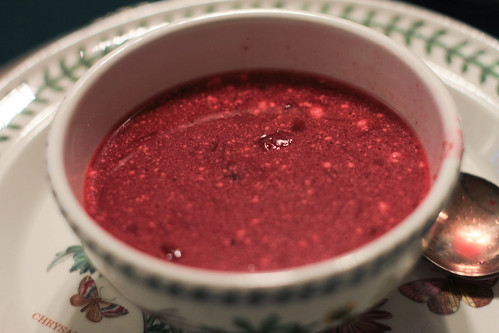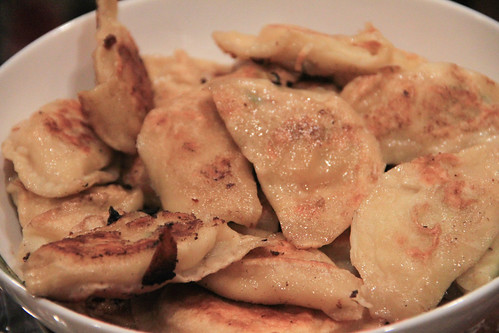Soon after sending out the invite for the meal, we got an email from someone named Ron. He couldn't make it to the date as scheduled, but he asked all sorts of questions and gave a bunch of advice and it was clear that this meal would be crafted under his guidance. After plenty of back-and-forth and an all-caps-and-bold insistence that I take some rare kielbasa from his freezer stash, we met up for coffee, a wide-ranging chat covering his growing up in Chicago and 35 years of experience shopping for food in Portland, and a sausage handoff. The stew recipe came directly from him, and he helped me craft a thorough menu. Thanks again, Ron, and we hope to see you at a future meal!

Joining us for this hearty and boozy meal — three shots, plus plenty of beer! — were Soumary, Jonas, Sarah, Sarah, Linda, David, Morgan, Jeanette, Amy, Russ, Lisa, and Eric.
Kapusta kiszona | Sauerkraut | Recipe
It used to blow me away that fresh sauerkraut's like nine dollars a jar in the cold case. Cabbage is extremely cheap, and making kraut is as easy as shred, mix with salt, pack, wait until it's sour, then refrigerate. Then I made kraut and realized that a whole head shrinks down to a quart after salting, and I no longer feel as squeezed.
Lacking the traditional fermentation crock, I found someone to lend me a few mason jar fermentation lids. It's arguably even easier that way, since the rising carbon dioxide forces out the oxygen that you keep away with carefully placed weights in a crock. I let the jars sit — in a pan, which is good because some brine followed the CO2 for the ride — until Laura complained about the smell, about a week later. Just as with the kim chi, the stink test worked: the kraut was crisp and funky, not too flabby and not too salty.

Chleb żytni na zakwasie | Sourdough rye bread | Recipe
I like making bread, and I'm often excited by the result. I'm very excited by how this turned out. Just enough crust to keep it interesting, a flavor rich enough to make it nice to eat on its own but not overpowering when paired with something...but really it's the texture that blows me away. A really consistent crumb, perfectly spongy, both excellent integrity and mouthfeel. YAY.
I replaced about 40% of the flour with locally grown hard red spring whole wheat flour. Otherwise, I did it exactly as specified, including building up the starter over a few days without discarding any — by the end of a few days that thing was funky. The dough was a lot easier to work with than most ryes I've used, I'm figuring because the souring process probably ate up a lot of the sugars that usually make it so diabolically sticky. Anyway, if you've got a sourdough starter and want to make a rye bread perfect for sandwiches, this is your recipe.

Barszcz czysty czerwony | Clear beet soup | Recipe
Poland is home to some fascinating soups. There's one made with fermented rye extract, another with dill pickles. Even the borscht, the famous Eastern European beet soup, is interesting. There are many ways it can be made, including one where you ferment beets for a few days and then pull that together into a soup, but this one really caught my eye. It's not even a soup in the classic sense, it's really a bouillon because it's an extract of beets and vegetables. For a brief moment it looks like a sparkling clear version of cranberry juice; with sour cream mixed in, it looks like strawberry soft serve.
The recipe above is exacting, and written in a curious sort of English that took a bit of syntactic analysis to unpack. But the result is really good. I ended up running out of time so I didn't make the mashed potato float, but all the same, the flavor was rich but not overpowering, a really pleasant start to a meal.

Bigos | Hunter's stew | Recipe
While pierogi is the best-known Polish dish in America, without question the true national dish is this ugly-but-goodie stew. While there's general agreement that it involves bite-sized meat and both sauerkraut and fresh cabbage, all the other details — what kind of meat, whether or what to use to sweeten it a bit, to add wine or not, the spices, and so on — are subject to some combination of family tradition and what odds bits of fresh, cooked, and preserved meats are laying around. To that point, the term bigos is also applied to anything that's a jumbled variety, much like we'd say "kitchen sink."
I followed the linked recipe fairly closely, except that for the meats I got the gaminess through buffalo, and used pork shoulder for the other bit. Ron was extremely kind to give me some of his Olympia Provisions kielbasa freezer stash, which he swears is the best you can get in Portland yet they only make it at Christmastime. I also did some research on making it ahead, and ended up cooking it to close to done on Tuesday, reheating it and simmering for an hour on Thursday, and then bringing it back once more for a few hours until the meal on Saturday. I tasted it at each point, and it went from pretty good to really good to wow. I'm glad we have some leftovers!

Pierogi | Stuffed dumplings | Recipes: Fillings, dough
Just about everyone loves dumplings. There's always something fun about dough-wrapped units of tasty morsels. So much the better if, as is often the case with pierogi, it's pan-fried so you get all sorts of textures.
You know what's less fun, at least for me? Making dumplings. I don't like rolling dough, I don't like bending over and doing repetitive fine motor tasks, whenever I stuff things I seem to not always fully enclose things so the filling goes all over the place, and then there's a last-minute rush to get everything onto the table halfway through the meal. To make it easier on myself I got a pierogi maker, a clever little frame where you lay down a sheet of dough, press some filling in, lay down another sheet, then roll down hard to fuse top dough to edges of bottom dough, and pop it out. That did make the assembly quite a bit easier, but still, I ended up running behind and thank goodness for Linda stepping in and helping finish up the assembly
The more fun part was the fillings. Especially the potato and cheese: we had a lot left over and I made patties of it for breakfast the next morning. I could eat that three times a week forever.

Naleśniki | Cheese-stuffed crepes | Recipe
This is the food of my childhood! On special occasions, or sometimes just because, my mom would churn out these crepes one by one — pour some batter, quickly swirl it around, flip it over, remove, repeat — then roll them with sweetened ricotta into little burritos, sear them on both sides with butter, and serve with yogurt and fruit. As most people in America who know this food, we call them blintzes. (It's a Yiddish term that comes from a diminutive of blin, the Russian word for pancake.)
The Poles call their crepes nalesniki, and often it's served other ways, especially rolled up more like flautas or even folded like quesadillas. (Mexican food terminology is useful here!) But blintz style is perfectly legit too, so that's what we did.
Because I didn't think I'd end up at a store that sold it, I made the farmer's cheese myself. Here's how I did it with the Instant Pot. I also threw together a sauce by simmering frozen blueberries, lemon zest and juice, and a bit of sugar. That's the easy part.
The tedious part is making those blintzes, one by one. It took me the better part of an hour to make about 25; next time I'll do two pans at once to reduce the time at the stove! One trick my mom figured out recently that helped reduce the mess is using a fat separator to dose out the batter: just pull the handle to dispense batter. (In an amazing stroke of luck, I found one at a garage sale the morning of the Nosh!) Thankfully this part can be done hours ahead of time, just cover the stack with waxed paper. Then roll up with sweetened farmers cheese right before searing and serving.
One more innovation to add to the blintz game: I was struggling to get my Griddler to open flat, when our guest Russ asked why not to just use it as a panini press to crisp both sides at once. Genius!
Oh, and they tasted great. Despite how much description I just gave, and the time it took, none of the work is particularly hard, and the chorus of delight from around the tables are the sign of a real winner.